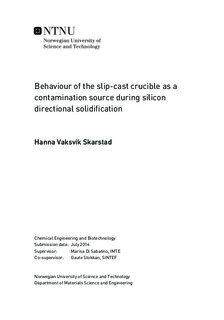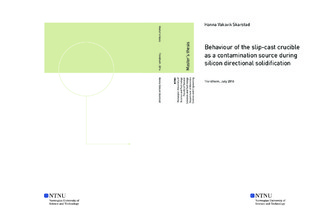| dc.description.abstract | In this work the behaviour of the slip-cast crucible as a contamination source of multicrystalline silicon during directional solidification (DS) was investigated. Transport parameters of iron were estimated in two types of amorphous silica materials; synthetic Heraeus quarts glass and a Vesuvius slip-cast crucible. The slip-cast crucible is porous and consists of sintered quartz glass particles, and has much lower density than the quartz glass. The diffusivity of iron the crucible and quartz glass was estimated at 1100, 1200 and 1300 °C. The solubility of iron has also been estimated in the quartz glass. Samples of both materials were heat treated in contact with a solid iron source to obtain contact diffusion. The diffusion profile of iron in quartz glass was obtained by using quantitative analysis (line scans) with an electron probe micro analyser. Semi-quantitative X-ray mapping was performed on the slip-cast crucible samples, followed by image analyses. The concentration profile of both materials were fit to the solution of Fick s diffusion equation under the appropriate conditions. The diffusivity of quartz glass was estimated to be on the order of 10^-15 and 10^-14 m^2/s over the range of 1100-1300 °C. The diffusivity of the crucible material was estimated to be on the order of 10^-14 and 10^-13 m^2/s over the range of 1100-1300 °C. The independent diffusion constants and activation energy of the diffusion were estimated for both materials. The diffusivity of the quartz glass and the crucible can expressed as D = 2,6×10^−13 exp((−44,9kJ/mol)/RT) m^2/s and
D = 1,2×10^−8 exp((−146,7kJ/mol)/RT) m^2/s, respectively. There was an order of magnitude difference between the diffusivity of the quartz glass and the slip-cast crucible. This indicates that the structure of the crucible affects the silicon contamination. The parameters obtained were applied in a finite element model that simulates the iron diffusivity across the crucible, coating and into the silicon melt during DS. The simulation resulted in a larger concentration in the melt when the values from the slip-cast crucible were applied. However, the difference from the quarts glass contamination was not as large as expected. It is reasonable to assume that if the simulation had been tested with even cleaner coating, a larger difference could have been observed. | |

